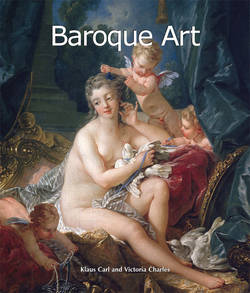Читать книгу Baroque Art - Victoria Charles - Страница 7
1. Baroque in Italy
Painting
Caravaggio
ОглавлениеOf unending industriousness, Caravaggio was the founder of Naturalism in Italian painting and was named after his place of birth. His real name was Michelangelo Merisi and he declared war not only on Mannerism and the Eclectic school but in fact on the whole world. Possessing a very impulsive nature, he moved frequently from place to place. When he finally found somewhere to settle down, some misdeed soon forced him to flee again.
Caravaggio’s models, who came equally from the high society of the times or the common people, including male and female prostitutes, were depicted in powerful reality and a bright golden colouring reminiscent of the Venetian. Probably the best known example is his Madonna of the Rosary (1606–1607) in which the dirty soles of the kneeling persons can be clearly seen, for which reason he was also sometimes vilified as the “Painter of the Dirty Soles”.
Giorgione had already earlier painted such genre pictures and it cannot be excluded that in this he was Caravaggio’s example. However, these pictures were all from Caravaggio’s early period when he was not so embittered by his experiences and impulsive acts. The Fortune-Teller (1595–1598) provides us with an insight to his darker sides while his Lute Player (1595) or the Youth bitten by a green Lizard (1593) shows the more cheery side of life in those times.
25. Guido Reni, The Massacre of the Innocents, 1611.
Oil on canvas, 268 × 170 cm.
Pinacoteca Nazionale di Bologna, Bologna.
26. Giovanni Francesco Barbieri, also known as Guercino, Dawn, 1621.
Fresco. Casino Ludovisi, Rome.
27. Giovanni Francesco Barbieri, also known as Guercino, Ecce Homo and St. Petronilla, 1622–1623.
Oil on canvas, 720 × 423 cm. Pinacoteca Capitolina, Rome.
28. Carlo Saraceni, St. Cecilia and the Angel, c. 1606.
Oil on canvas, 172 × 139 cm. Palazzo Barberini, Galleria Nazionale d’Arte Antica, Rome.
29. Michelangelo Merisi da Caravaggio, The Fortune-Teller, c. 1595–1598.
Oil on canvas, 99 × 131 cm. Musée du Louvre, Paris.
At the apogee of his career, Caravaggio developed and applied the principles of chiaroscuro by sharp, plastic, even hard modelling, by harsh contrasts in change between light and shadow, and by means of a brown-blackish overall tone. This new type of presentation was the basis of his fame as a Naturalist, even though this was what distanced him from Nature and caused his descent into subjective arbitrariness and possibly even into the grotesque. It is therefore easy to understand that an altarpiece with such violent positions and movements such as the painting for the San Luigi dei Francesi, the Calling of St. Matthew (1599–1600), caused anger in ecclesiastical circles and quickly had to disappear from the church. For the same reason, with the argument that the painting “of the Virgin is unworthy”, the Death of the Virgin (1605–1606) – in which the dying Virgin, appearing like a bloated corpse, surrounded by figures in exaggerated mourning – was rejected by the Carmelites from the Roman church della Scala.
And yet, with his Burial of Christ (1602–1604), originally commissioned for the chapel of the Family Francesco Vittrice, Caravaggio created a complete master work in composition, depicting mourning and pain and proving that his skill was second to none.
Because of his very chaotic lifestyle, Caravaggio did not found a school but seemed to have a certain influence on Jusepe de Ribera (called la Spagnoletto), who had emigrated from Spain and had been settled in Naples since 1616, becoming the leading master of the Neapolitan School. He absorbed certain elements from Caravaggio, which he added to the knowledge he had obtained from his teachers. Spagnoletto loved gloomy, tragic, and passionate themes as much as Caravaggio, and for this reason he painted similarly dark subject matter.
30. Michelangelo Merisi da Caravaggio, The Calling of St. Matthew, 1599–1600.
Oil on canvas, 322 × 340 cm.
San Luigi dei Francesi, Rome.
Spagnoletto’s preference for martyr scenes originated in Spain, as did the portrayal of holy women and men who went into spiritual ecstasies in experiencing heavenly revelations. Among these martyr scenes, his main work is certainly the etching Martyrdom of St. Bartholomew (c. 1624) who is hoisted by two executioner’s assistants onto a mast in order to be tortured and flayed. This type of picture was very popular in Spain because it fitted in so well with the religious spirit of the time. Despite this tendency to portray the ugly and terrible in almost reckless truth, this many-sided artist could also create idyllic scenes which were in sharp contrast to his mystic-lyrical religious pictures, and could depict the strengthening of spiritual might over simple feelings in naive impartiality. Something like this is shown in the pictures of Ribera’s daughter in St. Agnes (1641) who is brought a robe by an angel, and in the multiple characterisations in St. Sebastian (1651), of the saint tied to a tree and collapsed and transfixed by an arrow. In the depiction of the carpenter Joseph with Jesus, Ribera shows himself to be a true artist, whose study of the human body and insight into the soul revealed a new beauty that later made a very strong impression on another of the great Spanish masters, Bartolomé Esteban Murillo.
31. Michelangelo Merisi da Caravaggio, The Martyrdom of St. Matthew, 1599–1600.
Oil on canvas, 323 × 343 cm.
San Luigi dei Francesi, Rome.
32. Michelangelo Merisi da Caravaggio, The Death of the Virgin, 1601–1605/06.
Oil on canvas, 369 × 245 cm.
Musée du Louvre, Paris.
33. Michelangelo Merisi da Caravaggio, Madonna of the Rosary, 1606–1607.
Oil on canvas, 364 × 249 cm.
Kunsthistorisches Museum, Vienna.
34. Cristofano Allori, Judith with the Head of Holofernes, c. 1613.
Oil on canvas, 120.4 × 100.3 cm.
Palazzo Pitti, Florence.
